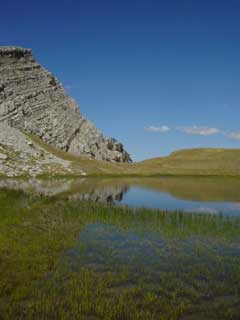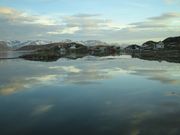 First worldwide map of groundwater resources crossing national boundaries has just been published by UNESCO
First worldwide map of groundwater resources crossing national boundaries has just been published by UNESCO
Almost 96 per cent of the planet's freshwater resources are found in
underground aquifers, most of which straddle national boundaries.
| Detail of UNESCO's global aquifer map. Click on image for full-size version. Click here for a legend to the map. |
What the UNESCO map reveals is just how many aquifers cross international borders. So far, the organisation has identified 273 trans-boundary aquifers: 68 in the Americas, 38 in Africa, 155 in Eastern and Western Europe and 12 in Asia.Each trans-boundary aquifer holds the potential for international conflict – if two countries share an aquifer, pumping in one country will affect its neighbour's water supply.
The map is the culmination of eight years of research and development of an extensive ground water database by UNESCO’s International Hydrological Programme (IHP).
Despite its strategic importance, no global
inventory of this resource had been compiled to date. The detailed map
of transboundary aquifers - available online - also indicates water
quality of the aquifers, recharge of the aquifers, streams and rivers
in the region of the aquifers, and population density near the aquifers.
The aquifers, which contain 100 times the volume of
fresh water that is to be found on the Earth's surface, already supply
a sizeable proportion of our needs. The growth in the demand for water
since the second half of the 20th century has been met by the increased
use of underground resources. Globally, 65 per cent of this utilization
is devoted to irrigation, 25 per cent to the supply of drinking water
and 10 per cent to industry.
| Massive amounts of water are used to irrigate cropland in California © Inga Spence/Holt Studios International |
Although aquifer systems exist in all continents,
not all of them are renewable. For example, those in north Africa and
the Arabian peninsula were formed more than 10,000 years ago when the
climate was more humid and are no longer replenished. In some regions,
even if the aquifers are renewable - being fed on a regular basis by
rainfall - they are in some cases endangered by over-exploitation or
pollution. In the small islands and coastal zones of the Mediterranean,
populations often use groundwater more rapidly than it is replenished.
The aquifers in Africa, however, which are some of
the biggest in the world, are still largely under-exploited. They have
considerable potential, provided that their resources are managed on a
sustainable basis. Since they generally extend across several State
boundaries, their exploitation presupposes agreed management mechanisms
in order, for example, to prevent pollution or over-exploitation by
particular States.
Mechanisms of this kind have begun to emerge in
recent years. For example, in the 1990s Chad, Egypt, Libya and Sudan
established a joint authority to manage the Nubian aquifer system in a
concerted manner. In their project concerning the Iullemeden aquifer,
Niger, Nigeria and Mali approved in principle a consultative mechanism
for administering the aquifer system. But such mechanisms are the
exception.
The draft Convention on transboundary aquifers, prepared by the United Nations International Law Commission with the assistance of experts from UNESCO's International Hydrological Programme (IHP), is therefore intended to fill a gap in the law. The text which was submitted to the General Assembly of the United Nations on 27 October, calls on aquifer States not to harm existing aquifers, to cooperate and to prevent and control their pollution.
Links:
Factfile: Groundwater depletion and pollution
| Contact information |
Isabelle LE FOURNIS / Agnès Bardon, Bureau de l'information du public. (UNESCO)
(email: i.le-fournis@unesco.org ; a.bardon@unesco.org) Phone: + 33 (0) 1 45 68 17 64 |
|---|---|
| News type | Inbrief |
| File link |
http://www.peopleandplanet.net/doc.php?id=3411 |
| Source of information | UNESCO / © People & the Planet 2000 - 2008 |
| Subject(s) | HYDRAULICS - HYDROLOGY , INFORMATION - COMPUTER SCIENCES , MEASUREMENTS AND INSTRUMENTATION , METHTODOLOGY - STATISTICS - DECISION AID , NATURAL MEDIUM , TOOL TERMS , POLICY-WATER POLICY AND WATER MANAGEMENT , RISKS AND CLIMATOLOGY |
| Relation | http://www.isarm.net/ |
| Geographical coverage | France |
| News date | 04/11/2008 |
| Working language(s) | FRENCH |
 you are not logged in
you are not logged in





